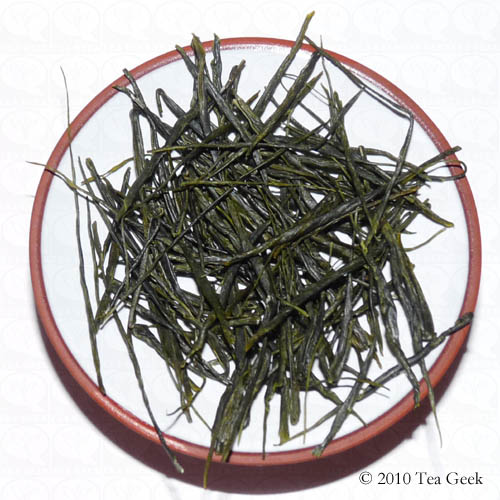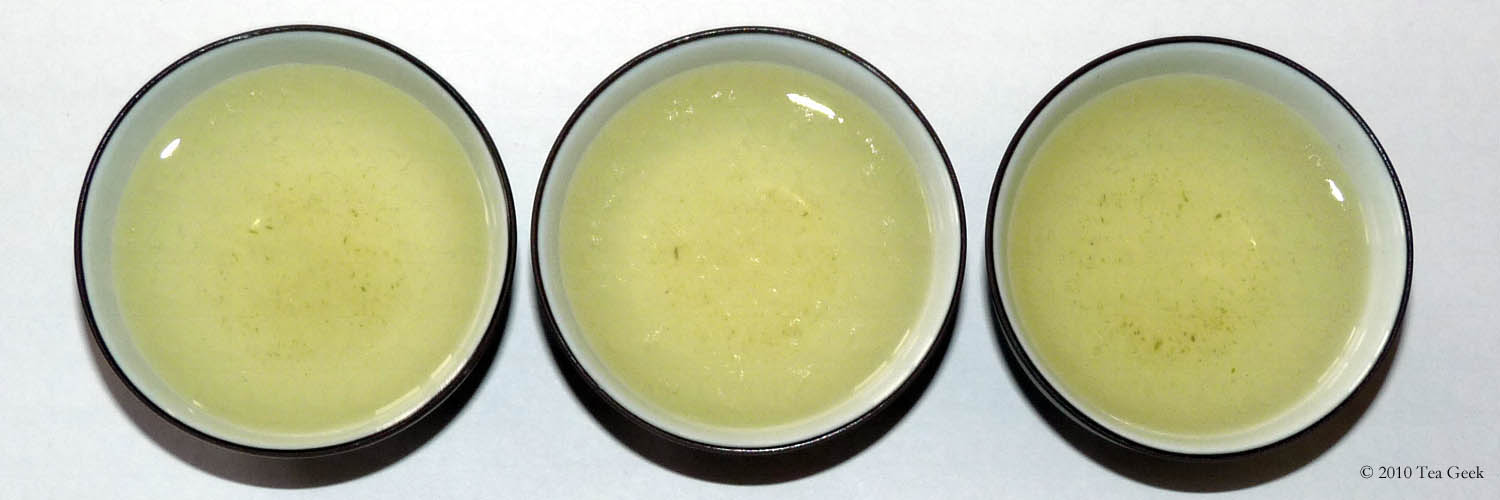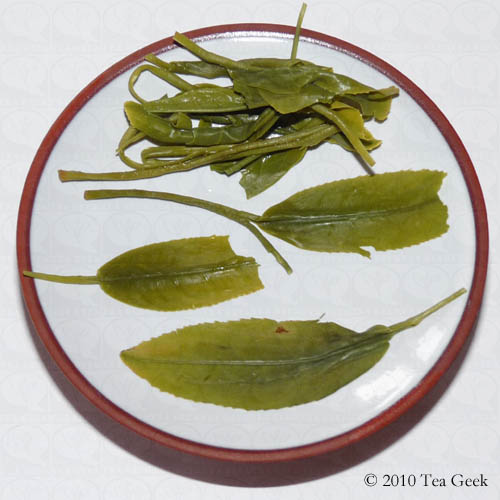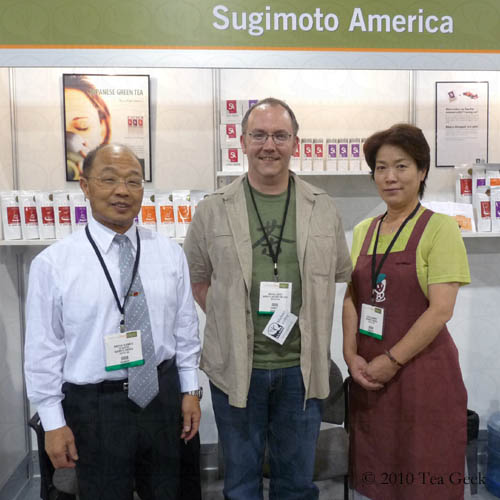Tasting Temomi Shincha
About a month ago, I was given a wonderful gift. Â Kyohei Sugimoto, head of Sugimoto USA, the American branch of Sugimoto Seicha Co., Ltd., was kind enough to give me a taste of Temomi Shincha that had been made by his mother, Kazue Sugimoto, and a group of temomi artists in Shizuoka, Japan.
 It came in a small, ornately decorated, foil bag with 10 grams of tea leaf–enough for a single brewing. Â According to the package, it was made on 26 April 2010, and that the group spent about 8 hours to make 2.2 pounds (1 kg) of finished tea. Â Unless I confused a decimal place somewhere, that means only 100 packages could be made.
It came in a small, ornately decorated, foil bag with 10 grams of tea leaf–enough for a single brewing. Â According to the package, it was made on 26 April 2010, and that the group spent about 8 hours to make 2.2 pounds (1 kg) of finished tea. Â Unless I confused a decimal place somewhere, that means only 100 packages could be made.
The term temomi means hand-kneeded, or as one Japanese scientific paper described it, “massaged by hand”. Â Shincha, of course, is the first picking of the season. Â So this Temomi Shincha is a hand-made tea made from the first leaves picked in 2010 from those plants. Â But that doesn’t really tell the whole story of this tea; in the highly mechanized world of Japanese green teas, this Temomi-cha was made entirely without machinery–just as the tea would have been made a couple of centuries ago. Â In that sense, the opportunity to taste this tea was an opportunity to go back in time.
 I followed the instructions that came with the tea package. Â I used a 5-ounce clay teapot as suggested (though it was a Chinese-style pot, but my Japanese teapot is both too large and has no filter; I’ve had some brewing disasters using it). Â The first brewing was for 3 minutes at 100F (40C). Â Much of the water was absorbed by the leaves, but the liquor produced was strong and brothy-sweet.
I followed the instructions that came with the tea package. Â I used a 5-ounce clay teapot as suggested (though it was a Chinese-style pot, but my Japanese teapot is both too large and has no filter; I’ve had some brewing disasters using it). Â The first brewing was for 3 minutes at 100F (40C). Â Much of the water was absorbed by the leaves, but the liquor produced was strong and brothy-sweet.
For those not used to really fantastic Japanese green tea, the strong flavor was there without any bitterness or astringency. Â This is due mainly to the use of cooler water, which pulls out more amino acids than it does the bitter catechins and caffeine. Â The flavor was dense, thick, and intense, but without an edge. Â It lingered after swallowing, too. Â Not as long as some great wulongs do, but more than almost any green I can think of.
 At another tea event with Kyohei Sugimoto, he had brewed some teas with cool water then switched to hotter water “so we can enjoy the bitterness.” Â The idea being that you brew cold for sweet, then hot for bitter, and that both are to be enjoyed as aspects of the tea leaf. Â The second and third brews were done with 130F (54C) water for a minute each, as per the instructions, and I did indeed enjoy the bitter. Â It wasn’t knock-your-socks-off bitter, but not out of line with other bitter foods. Â (I don’t drink alcohol, but my tasting partner described the bitterness of these steepings as somewhere between beer and bitters.) Â The photo above shows a sample from each steeping–I’m surprised by how little the color changes from the cold to hot brewing.
At another tea event with Kyohei Sugimoto, he had brewed some teas with cool water then switched to hotter water “so we can enjoy the bitterness.” Â The idea being that you brew cold for sweet, then hot for bitter, and that both are to be enjoyed as aspects of the tea leaf. Â The second and third brews were done with 130F (54C) water for a minute each, as per the instructions, and I did indeed enjoy the bitter. Â It wasn’t knock-your-socks-off bitter, but not out of line with other bitter foods. Â (I don’t drink alcohol, but my tasting partner described the bitterness of these steepings as somewhere between beer and bitters.) Â The photo above shows a sample from each steeping–I’m surprised by how little the color changes from the cold to hot brewing.
After drinking the tea, we ate the leaves–or at least the ones we didn’t pull out to examine and admire. Â The texture was something like lightly steamed spinach. Â The leaves still had a little bitterness left, but it wasn’t more than you’d find in the greens of a fancy salad.
Meeting the Maker
 It was my pleasure, then, a couple of weeks later to meet both Tea Maestro Hiroyuki Sugimoto and Temomi Master Kazue Sugimoto at the World Tea Expo. Â I expressed my thanks and honor at being able to try the Temomi Shincha that she had made. Â She asked (via an interpreter who, I’m embarrased to admit, I don’t recall the name of) if I’d like to try any of the teas they had on display. Â I chose the tea with the least well-known Japanese tea name, konacha, which is essentially the tea of Japanese sushi restaurants. Â She gave me a look that said, “Hmm, interesting choice.” Â Apparently, even though the expo was half over, nobody had yet asked to taste their konacha.
It was my pleasure, then, a couple of weeks later to meet both Tea Maestro Hiroyuki Sugimoto and Temomi Master Kazue Sugimoto at the World Tea Expo. Â I expressed my thanks and honor at being able to try the Temomi Shincha that she had made. Â She asked (via an interpreter who, I’m embarrased to admit, I don’t recall the name of) if I’d like to try any of the teas they had on display. Â I chose the tea with the least well-known Japanese tea name, konacha, which is essentially the tea of Japanese sushi restaurants. Â She gave me a look that said, “Hmm, interesting choice.” Â Apparently, even though the expo was half over, nobody had yet asked to taste their konacha.
Also, having had some heated discussions with American tea people about how Japanese green tea is “supposed” to be brewed, I asked Hiroyuki Sugimoto (with Kyohei serving as interpreter) how he brewed his tea. Â He said he always brewed his teas with boiling water. Â He explained that with boiling water, it is easier to tell if there are flaws in the tea making. Â I asked what he looked for as a sign of quality, he answered that it was a balance of factors. Â Essentially, he tasted a tea specifically looking for flaws. Â If he couldn’t find any, it was a good tea. Â He would be unable to distinguish a well-made tea from a poorly-made tea, then, unless he brewed it with boiling water.
I was thrilled to have been able to meet these wonderful people, and happy to share tea with them!








I was also lucky enough to taste this beautiful green tea. I did two 5 gram servings. That worked out really well but I probably didn’t get as many infusions each time. Those long cool steeps were definitely thick and brothy, although the color was a deceptively pale-watery-yellow. I’ve been trying long cool steeps with some other (more common) shincha too and getting good results.